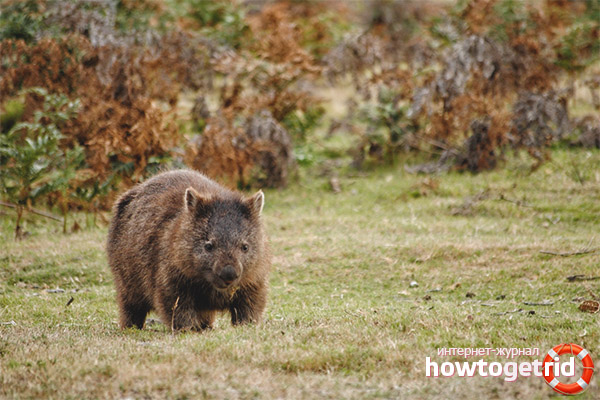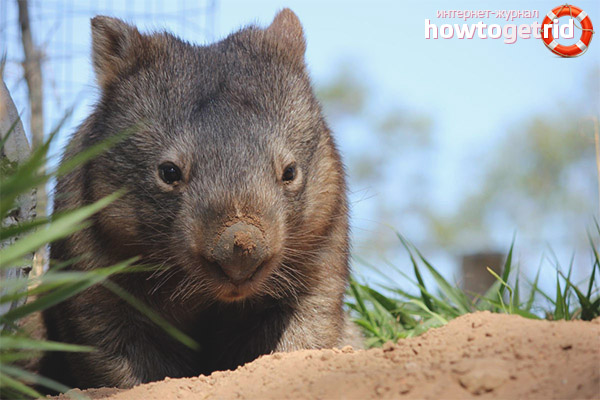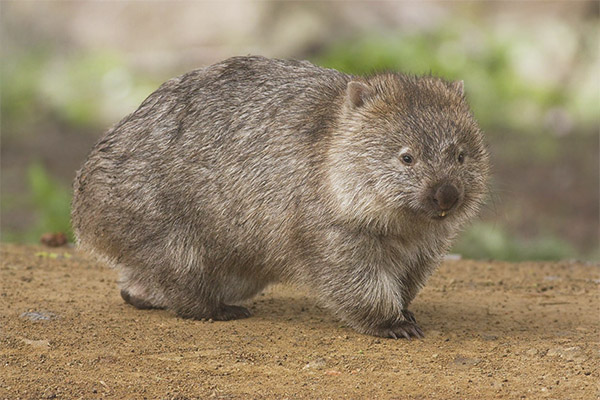The content of the article
Wombats are undoubtedly unique representatives of the animal world. After all, they existed on our planet many millions of years ago. Many species of this animal have died out, but we still have the opportunity to see them.
Today, there are 2 genera that belong to the family of wombats. They, in turn, includes 3 species. There is a short-haired wombat, as well as a genus of long-haired wombats, which includes the long-haired, as well as the Queensland wombat. Earlier on our planet there were many more species, but in the process of evolution, most of them disappeared. This contributed to a variety of reasons. It is known that there were at least 5 genera. Previously, pandas were considered relatives of these animals, as they have a lot in common.
But about 36 million years ago, these animals began to develop along different paths of evolution. As a result, they drifted away, and acquired their own characteristic features.If you look at the photographs of wombats and pandas, you can still trace a certain similarity.
Description
Wombats are herbivores. They live in Australia. Outwardly, representatives of this species look like small bears, and a bit like guinea pigs. The body length of adult individuals is approximately 70-120 cm, weight ranges from 20 to 40 kg.
The peculiarity of this species is that the back part of the body has an unusual structure compared to other mammals. On the back they have a lot of cartilage, hardened skin, there are bones. All this is a shield. The animal uses it to protect its home. For example, if someone wants to get into the hole to the wombat, the animal simply turns around to the entrance of the ass. So he blocks the passage into the hole, and then can crush the enemy against its walls.
Wombat head deserves special attention.Compared with the size of the body, it has a large size. The shape of the head is somewhat flattened. If the wombat is in danger, he can defend himself with his head or even use it to attack the enemy. At the same time, he makes movements that look like butting, although this animal has no horns.
The jaw and teeth in their structure have many similarities with the jaws of rodents. Compared with other marsupials, wombats have fewer teeth. From above and below they have 2 cutting incisors. In addition, there are chewing teeth. But the side missing.
These animals have very powerful strong paws. Each has 5 fingers, each of which has claws, necessary for animals to perform various actions. It is with these claws that wombats perfectly dig their burrows.
These animals are famous for their ability to dig up the whole kingdom under the ground. Many researchers believe that wombats are the most capable and largest diggers among all animals. One individual can dig a real tunnel, the length of which will be about 20 m, and the width of their hole reaches 3 m.Wombats are developing real underground castles in which they live with their families. Their paws are small in length. But this does not prevent animals from developing speeds of up to 40 km / h. If necessary, they can easily climb a tree or swim in a pond.
Lifestyle

Australia is home to these unusual animals, but they can also be found on the island of Tasmania.
In nature, there are many representatives of this species. But to see this animal can be infrequent. This is due to the fact that representatives of this species spend a lot of time underground. They live in areas where the soil is dry, not stony, there is no groundwater. Also, they are hampered by various tree roots and vegetation. They choose the soil in which it is easiest to dig a large spacious tunnel.
From such minks, which animals dig for their family, whole villages are built up underground. They consist of spacious dwellings, as well as small streets, through which animals easily move in their familiar environment. Most of the time they are in their own underground houses.Here they sleep in the daytime, and at night come to the surface in search of food.
Representatives of this species live in groups consisting of a large number of individuals. Such groups occupy a large territory. Often it can be a large field, whose area reaches 20-25 hectares.
Members of the group mark the territory with excrement, which resembles a cube in their form. In this way they define the boundaries of possessions.
These animals have a rather peaceful nature. Man, they are not afraid. In nature, they have no enemies. But, if someone encroaches on their territory, they will aggressively defend it. If they feel that danger is approaching, they immediately swing their big heads, make sounds that look like lowing.
The enemy often decides that it is better not to fight with such an aggressive enemy and leaves. But, if the opponent does not retreat, a battle may begin between the animals. Fighting wombats his head, as if butting the enemy. In general, representatives of this species lead a peaceful lifestyle, if they are not in danger.
Nutrition

These animals are considered real gourmets who eat only high-quality plants. They get food using their claws. Their favorite delicacy is juicy shoots, roots. They also love moss, berries and some types of mushrooms. With the help of their teeth, lips and keen sense of smell, these unique animals choose for themselves only the best food. They prefer the youngest not tough shoots, cut them to the very root, and enjoy excellent taste.
Breeding
Wombat breeding occurs at any time of the year, but in arid areas it may depend on the weather. They are marsupials, but their bags are not located in the front, but in the back. Thanks to this female, it is convenient to dig the ground, and no dirt gets into the bag.
Their pregnancy is very short - about 20 days. Only one cub is born. The female has two nipples on her body, but she cannot bear two babies at the same time. The little wombat is in the mother’s bag for about 8 months. She constantly cares about him. After that, he leaves the bag, but the mother still cares about the cub for about a year. These animals in the wild usually live about 15 years. When kept in captivity - up to 20-25 years. It depends on the food and conditions of detention.
Video: Wombat (Vombatidae)











To send